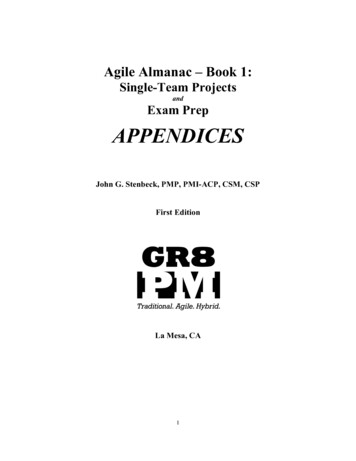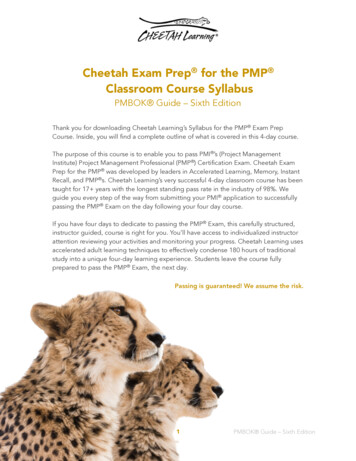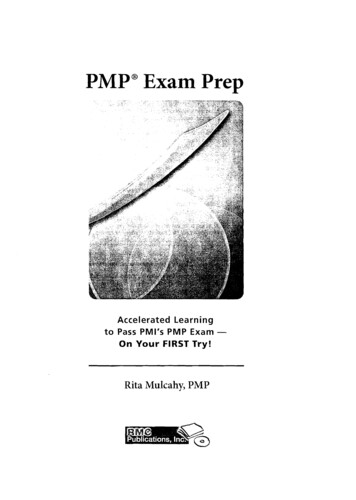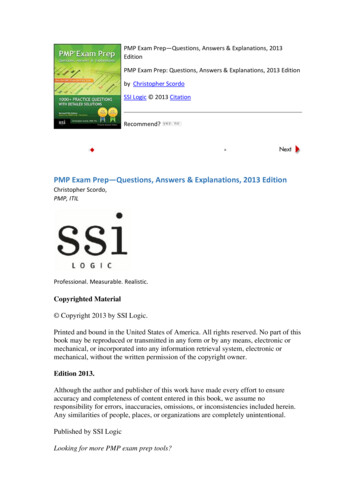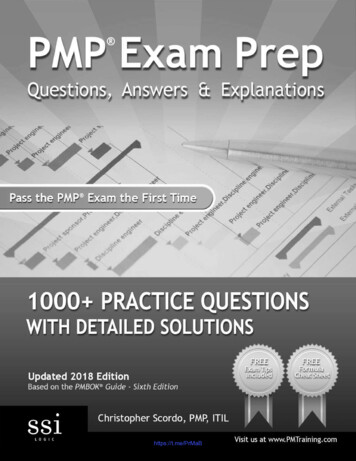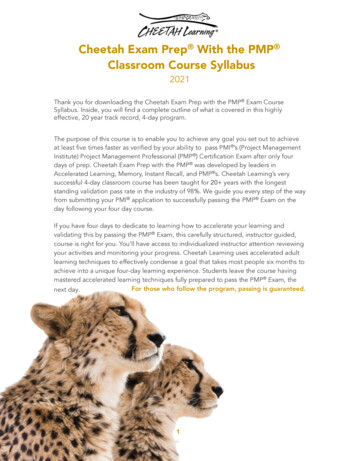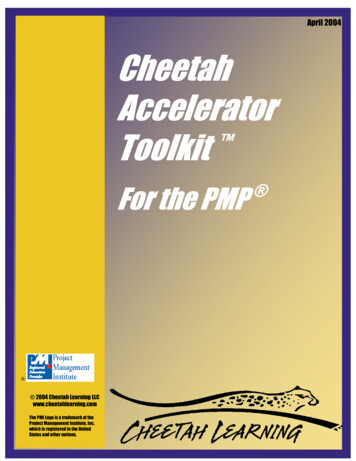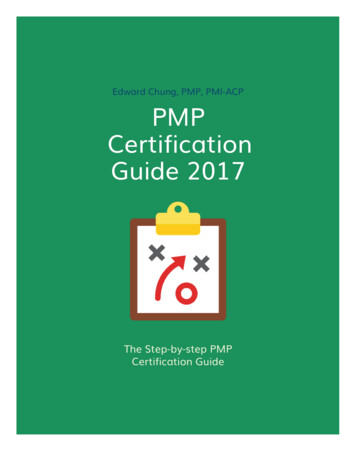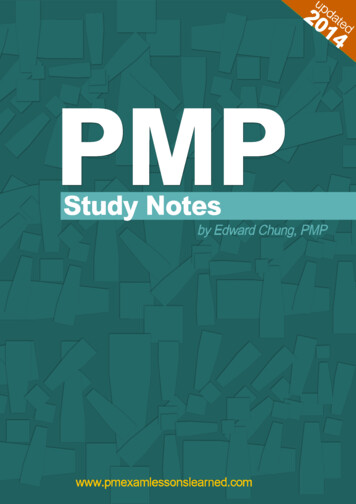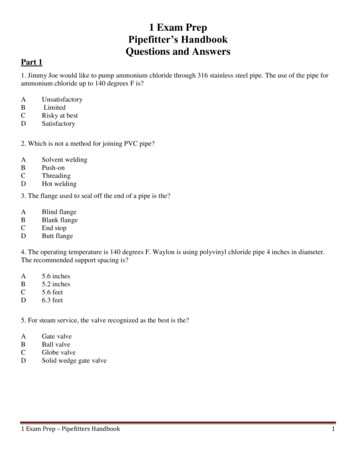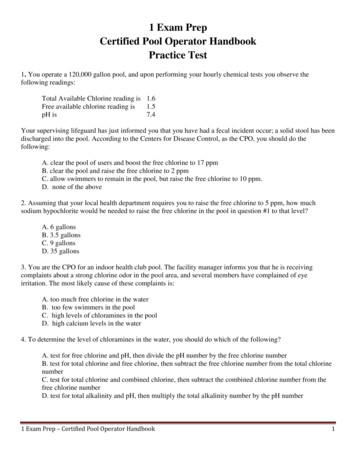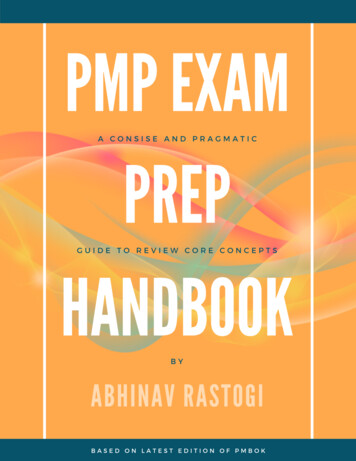
Transcription
2PMP Exam Prep Handbook
Table of ContentsIntroduction .5PMP Exam Overview .6Project Management Framework .7Project Management Processes .12Project Scope Management .151. Plan Scope Management Planning .152. Collect Requirements Planning .163. Define Scope Planning .174. Create WBS Planning .175. Validate Scope Monitoring and Controlling.186. Control Scope Monitoring and Controlling .19Project Schedule Management .231. Plan Schedule Management Planning .232. Define Activities Planning .233. Sequence Activities Planning .244. Estimate Activity Durations Planning .265. Develop Schedule Planning .276. Control Schedule Monitoring and controlling .30Project Cost Management .341. Plan Cost Management Planning .342. Estimate COSTS Planning .343. Determine Budget Planning .354. Control Costs Monitoring and controlling .37Project Quality Management .421. Plan Quality Management Planning .422. Manage Quality Executing .463. Control Quality Monitoring and Controlling .52Project Resource Management .561. Plan Resources Management Planning .562. Estimate Activity Resources Planning.573. Acquire Resources Executing .584. Develop Team Executing .595. Manage Team Executing .606. Control Resources Monitoring and Controlling .61PMP Exam Prep Handbook3
Project Communications Management .631. Plan Communication Management Planning .632. Manage Communications Executing .643. Monitor Communication Monitoring and Controlling .65Project Risk Management .671. Plan Risk Management Planning .672. Identify Risks Planning.673. Perform Qualitative Risk Analysis Planning .684. Perform Quantitative Risk Analysis Planning .705. Plan Risk Responses Planning .726. IMplement Risk Responses Executing.747. Monitor Risks Monitoring and Controlling .74Project Procurement Management .761. Plan Procurement Management Planning .762. Conduct Procurements Executing.783. Control Procurements Monitoring and controlling .78Project Stakeholder Management .801. Identify Stakeholders Initiating .802. Plan Stakeholder Engagement Planning .813. Manage Stakeholder Engagement Executing .814. Monitor Stakeholder Engagement Monitoring and controlling .82Project Integration Management.841. Develop Project Charter Initiating.842. Develop Project Mangement Plan Planning .853. Direct and manage Project Work Executing .864. Manage Project Knowledge Executing .865. Monitor and Control Project Work Monitoring and Controlling .876. Perform Integrated Change Control Monitoring and Controlling .887. Close Project or Phase Closing .88Formula Sheet .901. Earned Value .902. Communication Channels .903. Estimation .91Preparation And Exam Taking Tips .924PMP Exam Prep Handbook
PMP EXAM OVERVIEWThe PMP certification exam has 200 multiple-choice questions. You are allowed fourhours to complete the exam. Once you get your PMP certification, you will need tomaintain PMP active status which requires that you must earn 60 professionaldevelopment units (PDUs) every three years. This can be done in various ways such asattending PMI recognized events, watching podcasts, completing courses andconducting project management.ELIGIBILITYAccording to PMI, to apply for the PMP, you need to have either: A secondary degree (high school diploma, associate degree etc.) with at least fiveyears of project management experience (7,500 hours leading and directingprojects and 35 hours of project management education) A four-year degree (e.g. bachelor’s degree) and at least three years of projectmanagement experience, with 4,500 hours leading and directing projects and 35hours of project management educationThe PMP certification exam is comprised of questions from five main projectmanagement processes. It is important to note that for PMP exam, you need tounderstand project management from the PMI’s perspective which is described inPMBOK guide. As you start preparing for this exam here are few things to remember. Whenever the exam mentions “project”, think of it from the perspective of large(around 10 million dollar or more) projects. Your project management experiencemay be helpful, but it is not sufficient to pass the exam. Don’t procrastinate! Manage your PMP exam preparation like any other project.Build your own study schedule and be consistent with your preparation plan.The diagram below shows the percentage of questions that are on exam from each ofthe project management processes:6PMP Exam Prep Handbook
PROJECT MANAGEMENT FRAMEWORKThe first three chapters of PMBOK establish common vocabulary, environmentin which projects operate and role of project manager as defined by PMI. It is importantthat you develop a very good understanding of the terms defined in the first threechapters. During the exam, whenever a question refers to a project, portfolio, projectmanagement office etc., you should be able be understand it in terms of the PMI’sdefinitions. It may be tempting to answer based on your experience, which may or maynot be aligned with the PMI definitions. For the exam, think of projects with largeteams, US 10 million plus budget, separate Project Management Office (PMO) andteams spread across different countries. It is also important to note that a project as perPMI is a temporary endeavor, which indicates that it must have a specific beginningand end, unlike operations which continue indefinitely.For a Project Manager (PM), it is important to understand strategic objectives of aportfolio as that helps to understand the overall vision for various projects andprograms that are part of that portfolio. The PM needs to understand the degree ofcontrol and influence of the PMO office, which can be supportive, controlling, ordirective.Projects often take place in environments that may not be in the Project Manager’scontrol. It is important for a Project Manager to understand organizational culture andstructure. Organizational culture refers to vision, motivation, reward systems, code ofconduct, work ethic, work hours etc. Organizational structure refers to characteristics ofthe organization such as functional, weak matrix, balanced matrix, strong matrix, andprojectized. It is essential for a Project Manager to know the organizational structure tounderstand his authority and control over resources. The Project Manager has mostauthority and control over a project in a projectized and least-in functional organization.PMP Exam Prep Handbook7
In addition to structure, the PM also needs to know Organizational Process Assets(OPA) that are divided broadly into two categories.1. Processes and procedure: Guideline, criteria, policies, templates, change controlprocedures, financial control procedures, issues and defect managementprocedures, organizational communication requirements, procedures for workauthorizations, risk control procedures, proposal evaluation criteria and projectclosure requirements2. Corporate knowledge base: This includes databases such as configurationmanagement, financial information (labor hours, incurred costs, budgets etc.),historical information and lessons learned, issues and defects, processmeasurement, historical project files etc.OPA are inputs to most planning processes and can be big time savers for most newprojects. OPA provide common, organization-specific procedures that needs to befollowed.There are certain conditions that not under the control of the project team but doaffect the project team. These are referred to as enterprise environmental factors(EEF). The Project Manager needs to understand and educate his team about EEF.These include organizational culture, geographic distribution of resources and facilities,infrastructure, exiting HR, market conditions, and project management informationsystems. Sometimes these are also referred to as baggage that the PM gets with aproject.Although most projects vary in size and complexity but follow following genericproject life cycle as shown below:8PMP Exam Prep Handbook
As a PM, you also need to understand and be cognizant of the impact of changerequests in terms of risk and cost with time as shown by following chart.This chart shows that as the time progresses, it becomes more and more expensiveto execute change requests which makes sense for most cases if you think about it.PROJECT LIFE CYCLESPredictive or fully planned or waterfall life cycles are the ones where project scope,time and cost are determined as early as possible. These methodologies are morepopular for construction projects.Adaptive or agile life cycles or rolling wave planning or progressive elaborationlife cycles are the ones in which project phases (or iterations) intentionally repeat one ormore project activities as the project team’s understanding of the project increases andrequire ongoing stakeholder involvement. These methodologies are more popular forsoftware development projects.PMP Exam Prep Handbook9
THINGS TO REMEMBER 10Project: Temporary endeavor to create a unique product, service or resultProgram: Group of related projects, subprograms, and program activities managedin a coordinated way to obtain benefits not available from managing themindividuallyPortfolio: Project, programs, sub-portfolios, and operations managed as a group toachieve strategic objectivesProject Management: Applications of skills, tools and techniques to projectactivities to meet project requirementsProgram Management: The application of knowledge, skills, tools and techniquesto a program in order to meet program requirements and to obtain benefits andcontrol not available by managing projects individuallyPortfolio Management: Centralized management of one or more portfolios toachieve strategic objectivesOperations Management: Operations management is concerned with the ongoingproduction of goods and/or services. It ensures that business operations continuewell by using the optimal resources needed to meet customer needs.Competing Project Constraints: Cost, time, scope, resources, risk, qualityOrganizational Project Management (OPM): Strategy execution frameworkutilizing project, program, and portfolio management as well as organizationalenabling practices to consistently and predictably deliver organizational strategyProject Management Office: Helps with standardizing governance. Three forms ofa PMO are:o Supportive (Low Control): Consultative role by supplying templates, bestpractices, training access to information and lessons learnedo Controlling (Moderate Control): Provide support and require compliancethrough various meanso Directive (High Control): Take control of projects by directly managing projectsOrganizational Project Maturity Model (OPM3): Examines an enterprise’s projectmanagement process capabilitiesBusiness Value: The entire value of the business, the total sum of all tangible andintangible elementsKey Competencies of a PM:o Knowledge: Refers to what the PM knows about project managemento Performance: Refers to what the PM is able to do or accomplish while applyinghis or her project management knowledgeo Personal: Encompasses attitudes, core personality characteristics, andleadership, which provide the ability to guide the project teamPMP Exam Prep Handbook
Organizational Structures:o Functional: One employee has one identified superioro Matrix: Blend of functional and projectized characteristics Weak Matrix: Mostly functional. The PM is like a coordinator/expeditor(cannot enforce/make decisions) Balanced Matrix: Recognizes the need for a PM but doesn’t give fullauthority over project and funding. Strong Matrix: Mostly Projectized. PMs have considerable authorityo Projectized: PMs have independence and authority over project decisions. Oneemployee can either report to the PM or provide support services for otherprojectsEnterprise Environmental Factors: Company culture and existing systems thatproject would have to useo Project Management Information Systems (PMIS): Software systems forproject management such as data storage system, scheduling system, timetracking system etc.Organizational Process Assets: Processes, procedures and historical informationspecific to the organizationStakeholder: An individual, group, or organization who may affect, be affected by,or perceive itself to be affected by decision, activity, or outcome of a project. Allthese entities could be internal or external. Such as Project Sponsor, customers,users, sellers, business partners, organizational groups, functional managers,government regulators, consultants, subject matter experts (SME)Project Life Cycle:o Plan Driven: Waterfall methodology-based projectso Change Driven: Agile, change driven or iterative methodology-based project Product Backlog: Decomposed set of requirements and work to beperformedOperations vs Project:o Project: Time bound; once the objective is met, it ceases to existo Operation: Continues indefinitely to sustain core business and continues to existProject Management Business Documents:o Project Business Case: Organizations typically perform needs analysis andeconomic feasibility study to proceed with or cancel proposed project.o Project Benefits Management Plan: This document details the benefits and liststhe procedures to measure those benefits.PMP Exam Prep Handbook11
This graphic provides another way to visualize processes groups within a project.Here you can see outputs from initiating process are fed to planning process.Monitoring and controlling are conducted throughout the project life cycle or phase lifecycle. For a big project with multiple phases, the grey box can repeat multiple times foreach phase.To summarize this chapter, a project can have multiple phases. For example, phase 1for market research, phase 2 for prototype development and so on. Each process groupshould be performed in each phase. Initiating processes at the start of each phase helpsto keep the project focused. At the closing stage of a project or phase, success criteriaare verified, and decisions made to continue with the project or make changes ifrequired.Another frequently asked question on the PMP exam requires an understanding ofthe difference between Work Performance Data, Work Performance Information andWork Performanc
PMP Exam Prep Handbook 3. . The PMP certification exam is comprised of questions from five main project management processes. It is important to note that for PMP exam, you need to understand project management from the PMI’s perspective which is described in PMBOK guide. As you start
